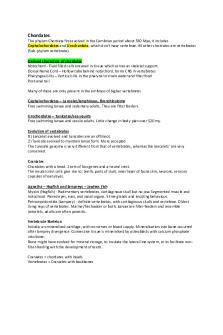12 - Chordates - Lecture notes 12 PDF

| Title | 12 - Chordates - Lecture notes 12 |
|---|---|
| Author | Samantha Smith |
| Course | Biodiversity |
| Institution | University of Stirling |
| Pages | 1 |
| File Size | 54.3 KB |
| File Type | |
| Total Downloads | 51 |
| Total Views | 213 |
Summary
Dr Joanne Clarke...
Description
Chordates The phylum Chordata first evolved in the Cambrian period about 530 Mya, it includes Cephalochordates and Urochordata, which don’t have vertebrae. All other chordates are vertebrates (Sub-phylum vertebrata). Derived characters of chordates Notochord - Fluid filled cells encased in tissue which serves as skeletal support. Dorsal Nerve Cord – Hollow tube behind notochord, forms CNS in vertebrates Pharyngeal slits – Vertical slits in the pharynx to strain water and filter food Post-anal tail Many of these are only present in the embryos of higher vertebrates Cephalochordates – Lancelet/Amphioxus, Branchiostoma Free swimming larvae and sedentary adults. They are filter feeders. Urochordates – Tunicates/sea squirts Free swimming larvae and sessile adults. Little change in body plan over 520 my. Evolution of vertebrates 1) Lancelet evolved and tunicates are an offshoot. 2) Tunicate evolved to maintain larval form. More accepted The tunicate genome is very different from that of vertebrates, whereas the lancelets’ are very conserved. Craniates Chordates with a head. 2 sets of hox genes and a neural crest. The neural crest cells give rise to: teeth, parts of skull, inner layer of facial skin, neurons, sensory capsules of ears/eyes. Agnatha – Hagfish and lampreys – Jawless Fish Myxini (Hagfish) - Rudimentary vertebrates, cartilaginous skull but no jaw. Segmented muscle and notochord. Paired eyes, ears, and nasal organs. Slime glands and knotting behaviour. Petromyzidontida (Lamprey) - definite vertebrates, with cartilaginous skulls and vertebrae. Oldest living reps of vertebrates. Marine/freshwater or both. Larvae are filter-feeders and resemble lancelets, adults are often parasitic. Vertebrate Skeleton Initially un-mineralized cartilage, with no nerves or blood supply. Mineralisation into bone occurred after lamprey divergence. Connective tissue is mineralised by osteoblasts with calcium phosphate into bone. Bone might have evolved for mineral storage, to insulate the lateral line system, or to facilitate nonfilter-feeding with the development of teeth. Craniates = chordates with heads Vertebrates = Craniates with backbones...
Similar Free PDFs

12 - Lecture notes 12
- 3 Pages

Chapter 12 - Lecture notes 12
- 4 Pages

Lab 12 - Lecture notes 12
- 5 Pages

LEC 12 - Lecture notes 12
- 3 Pages

(12) Mistake - Lecture notes 12
- 8 Pages

Chapter 12 - Lecture notes 12
- 9 Pages

Lecture notes, lecture 12
- 9 Pages

Lecture notes, lecture 12
- 7 Pages

Sachvui - Lecture notes 12
- 271 Pages

Mujadid - Lecture notes 12
- 1 Pages

Lecture 11 + 12 notes
- 16 Pages
Popular Institutions
- Tinajero National High School - Annex
- Politeknik Caltex Riau
- Yokohama City University
- SGT University
- University of Al-Qadisiyah
- Divine Word College of Vigan
- Techniek College Rotterdam
- Universidade de Santiago
- Universiti Teknologi MARA Cawangan Johor Kampus Pasir Gudang
- Poltekkes Kemenkes Yogyakarta
- Baguio City National High School
- Colegio san marcos
- preparatoria uno
- Centro de Bachillerato Tecnológico Industrial y de Servicios No. 107
- Dalian Maritime University
- Quang Trung Secondary School
- Colegio Tecnológico en Informática
- Corporación Regional de Educación Superior
- Grupo CEDVA
- Dar Al Uloom University
- Centro de Estudios Preuniversitarios de la Universidad Nacional de Ingeniería
- 上智大学
- Aakash International School, Nuna Majara
- San Felipe Neri Catholic School
- Kang Chiao International School - New Taipei City
- Misamis Occidental National High School
- Institución Educativa Escuela Normal Juan Ladrilleros
- Kolehiyo ng Pantukan
- Batanes State College
- Instituto Continental
- Sekolah Menengah Kejuruan Kesehatan Kaltara (Tarakan)
- Colegio de La Inmaculada Concepcion - Cebu




